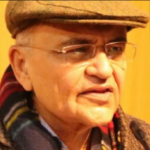We live in an era where lies and half-truths are warp and woof of public discourse. One oft-repeated lie is that Hindu-Muslim tension in India is a post-2014 phenomenon. Prior to Modi being voted to power, all was hunky-dory, between the two communities.
Nothing could be farther from the truth. Though Hindu-Muslim relations, spanning 1400 odd years, had a cordial start, but for most of the time, ranged between bitter hostility and uneasy, opportunistic, short-lived alliances. In 629 CE, during Prophet Muhammad’s lifetime (570-632 CE) visiting Arab traders requested Cheraman Perumal, a local Hindu king, for a place to worship, and got a mosque built in Methala, Kodungallur, Thrissur, Kerala in 629 CE.
This was the first mosque built outside Arabia. It continued to function normally under the patronage of successive Hindu Kings and was pulverised by the Portuguese Catholics in 1504. The mosque, since renovated several times over, is still functional.
The nascent Hindu-Muslim fraternal ties were, however, disrupted when Mohammad bin Qasim subjugated Sindh in 712 CE and introduced the practice of allowing Hindus to live as zimmis on payment of jizya. The Arab conquest of Sindh, was followed by Mahmud Ghazni’s raids into India in the early eleventh century.
According to Abraham Eraly (The Age of Wrath), “Mahmud had, during the solemn ceremony of receiving the Caliphate honours on his accession to the throne of Ghazni, taken a vow to wage jihad, holy war, every year against the idolaters of India. He could not keep that vow to the letter, but he did lead more than a dozen campaigns into India during his 32 year reign. The sultan had two motives in his Indian raids, to slaughter heathens and to gather plunder. These were, however, interconnected motives, each reinforcing and energising action in the other.”
What Erlay says about Ghazni’s intent in raiding India, holds true for the successive Islamic invaders as well. Two centuries after Ghazni, Muhammad Ghori attacked India, leading to the establishment of the Delhi Sultanate, which lasted 320 years. In 1526, Babur descended upon India, founded Moghul dynasty that ended , with the collapse of 1857 Indian uprising against British colonisers.
Notwithstanding their mutual hostility, or apparent differences- in their lineage, country of origin, language, or style of functioning – most of the Islamic invaders shared one attribute- scalding hate for ‘Kafirs’ and ‘Kufur’- and a fanatic zeal to wipe-out both. Memoirs of these iconoclasts, are replete with blood-curdling gory details of atrocities perpetuated against infidels, and claiming religious merit for their gory deeds.
After the demise of Aurangzeb in 1707, Islamic power started waning .Subsequently, Marathas, Rajputs and Jats in southern, western and northern India and Sikhs in Punjab asserted themselves against Islamic onslaught. It was no longer an unequal relationship between the two communities.
For a while relations between the two hostile communities were on an even keel. There were occasional power-sharing arrangements, opportunistic alliances, and sometimes, even sincere mutually beneficial pacts. It was against this backdrop that Hindus and Muslims in 1857 launched a joint war, though an unsuccessful one, against a common enemy, the British.
However, for centuries the Muslims had prided themselves as ‘rulers’ with a ‘religious obligation’ to stamp-out ‘Kufur’ from the Indian subcontinent. It did not take long for the British to rekindle the misplaced pride in their past and raise fears in them about an uncertain future , where they would have to deal with Hindus as equals.. In Sir Syed Ahmed Khan (1817-1898), the wily Britishers found an ace henchman to do their bidding. Sir Syed, continuously harangued Congress, called upon Muslims to side with the British and have an adversarial relationship with Hindus.
Just sample Sir Syed’s divisive message to Muslims. Speaking at Meerut (March 16, 1888) he said “is it possible that under these circumstances two nations – the Mohammedans and the Hindus – could sit on the same throne and remain equal in power? Most certainly not. It is necessary that one of them should conquer the other. To hope that both could remain equal is to desire the impossible and the inconceivable.
“No Mohammedan can say that the English are not ‘people of the Book’. No Mohammedan can deny this: that God has said that no people of other religions can be friends of the Mohammedans except the Christian”. Indian Muslims, by and large, headed Sir Syed bigoted call, ignored Gandhi Ji, stayed away from Congress, collaborated with the British , and succeeded in getting for themselves a separate Islamic nation – Pakistan.
In 1919, Indian Muslims started a movement for restoration of Khilafat in Turkey – it had nothing to do with India. Gandhiji, led it- with disastrous consequences for Hindus and for the country. In no time, the movement lapsed into widespread communal riots, culminating in Moplah atrocities on Hindus in Kerala and in Kohat, in Punjab (now in Pakistan). Worse, it spurred the Pan Islamic feelings among Muslims, ultimately leading to the creation of Pakistan.
In the aftermath of ‘Khilafat’ movement, Mrs. Annie Besant (Congress President 1917), said, “But since the Khilafat agitation, things have changed… that the inner Muslim feeling of hatred against ‘unbelievers’ has sprung up, naked and unashamed, as in the years gone by.
“We have seen revived, the old Muslim religion of the sword, ….the old exclusiveness…. we have heard Muslim leaders declare that if the Afghans invaded India, they would join their fellow believers, and would slay Hindus who defended their motherland against the foe: we have been forced to see that the primary allegiance of Musalmans is to Islamic countries, not to our motherland, we have learned that their dearest hope is to establish the ‘Kingdom of God’, not God as Father of the world, loving all his creatures, but as a God seen through Musalman spectacles.
“The claim now put forward by Musalman leaders that they must obey the laws of their particular prophet above the laws of the State in which they live, is subversive of civic order and the stability of the State: it makes them bad citizens for their centre of allegiance is outside the nation.”
In 1924 an editor of a Bengali paper interviewed the Nobel Laureate, Dr. Rabindra Nath Tagore. His report of this interview states “… another very important factor which, according to the poet, was making it almost impossible for the Hindu-Mohamedan unity to become an accomplished fact was that the Mohamedans could not confine their patriotism to any one country…. The poet said that he had very frankly asked many Mohamedans whether, in the event of any Mohamedan power invading India, they would stand side by side with their Hindu neighbours to defend their common land. He said that he could definitely state that even such men as Mr. Mohamed Ali had declared that under no circumstances was it permissible for any Mohamedan, whatever his country might be to stand against any other Mohamedan.”
We can glean into the state of Hindus-Muslim ties in that era – through the observations of Mrs Besant and Dr. Tagore. Subsequent events proved them right. Horrendous riots shattered Kolkata in 1946 following a call for “Direct Action Day” by Muslim League in support of its demand for Pakistan. Within a year, Pakistan was a reality in which non-Muslims had no place whatsoever. In 1980-1990, the same story was repeated in Kashmir Valley.
Recent beheading of Kanhaiya Lal in Udaipur and of Umesh Kolhe in Amravati, threats to BJP leader Nupur Sharma, and several others and repeated attacks on religious processions of Hindus on Hanuman Jayanti and Ram Navmi, months-long sit-in protests against CAA-NRC are in fact a sordid continuation of the same divisive hate soaked mindset- so aptly captured by Mrs Besant and Dr Tagore 100 odd years ago. Have things changed since? Let readers take the call.
![]()
- WHEN WAS JESUS BORN? - December 25, 2022
- Fall & Fall of Communist Party of India - August 3, 2022
- Myth & Reality of Hindu-Muslim Ties - July 26, 2022


